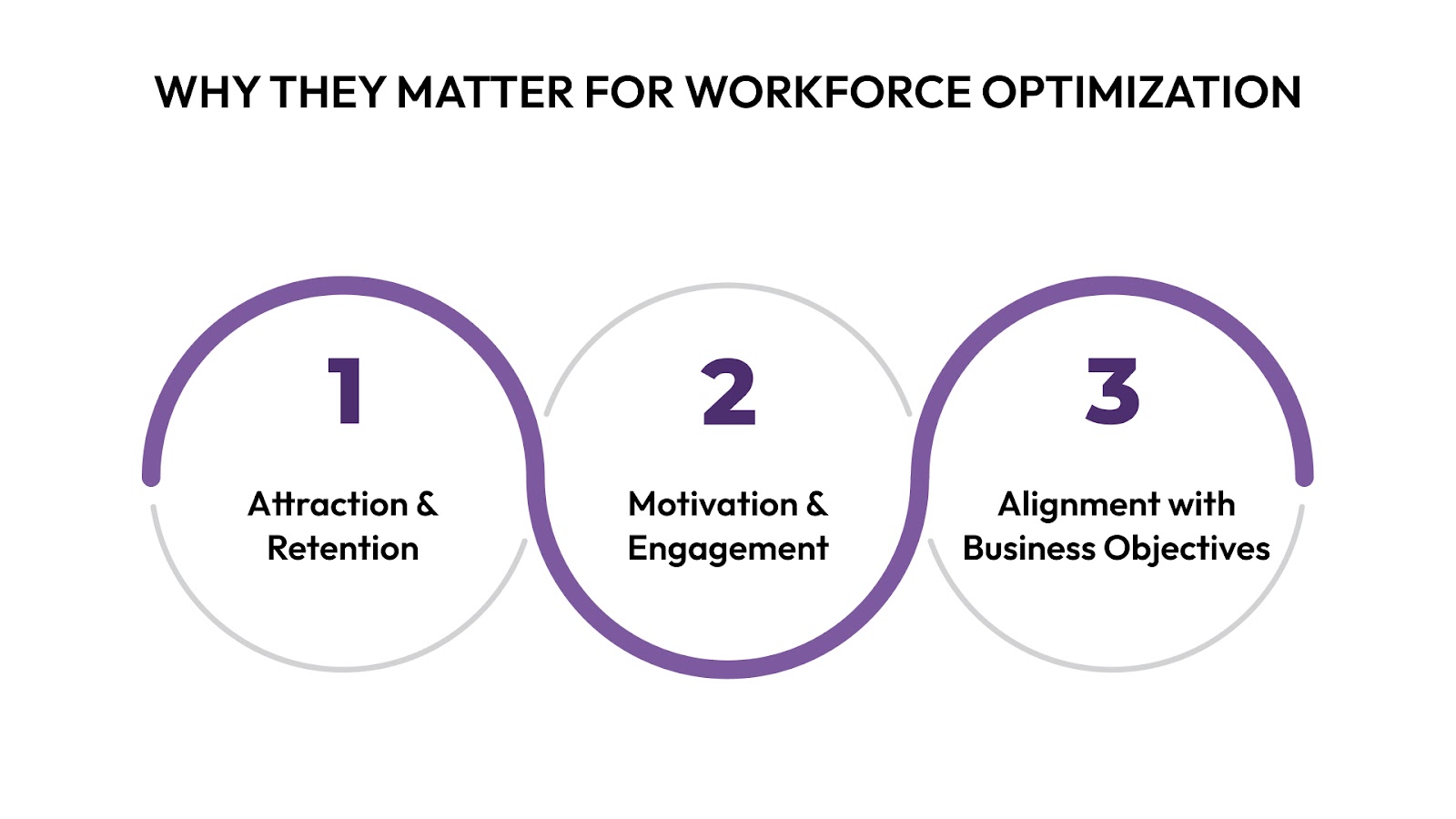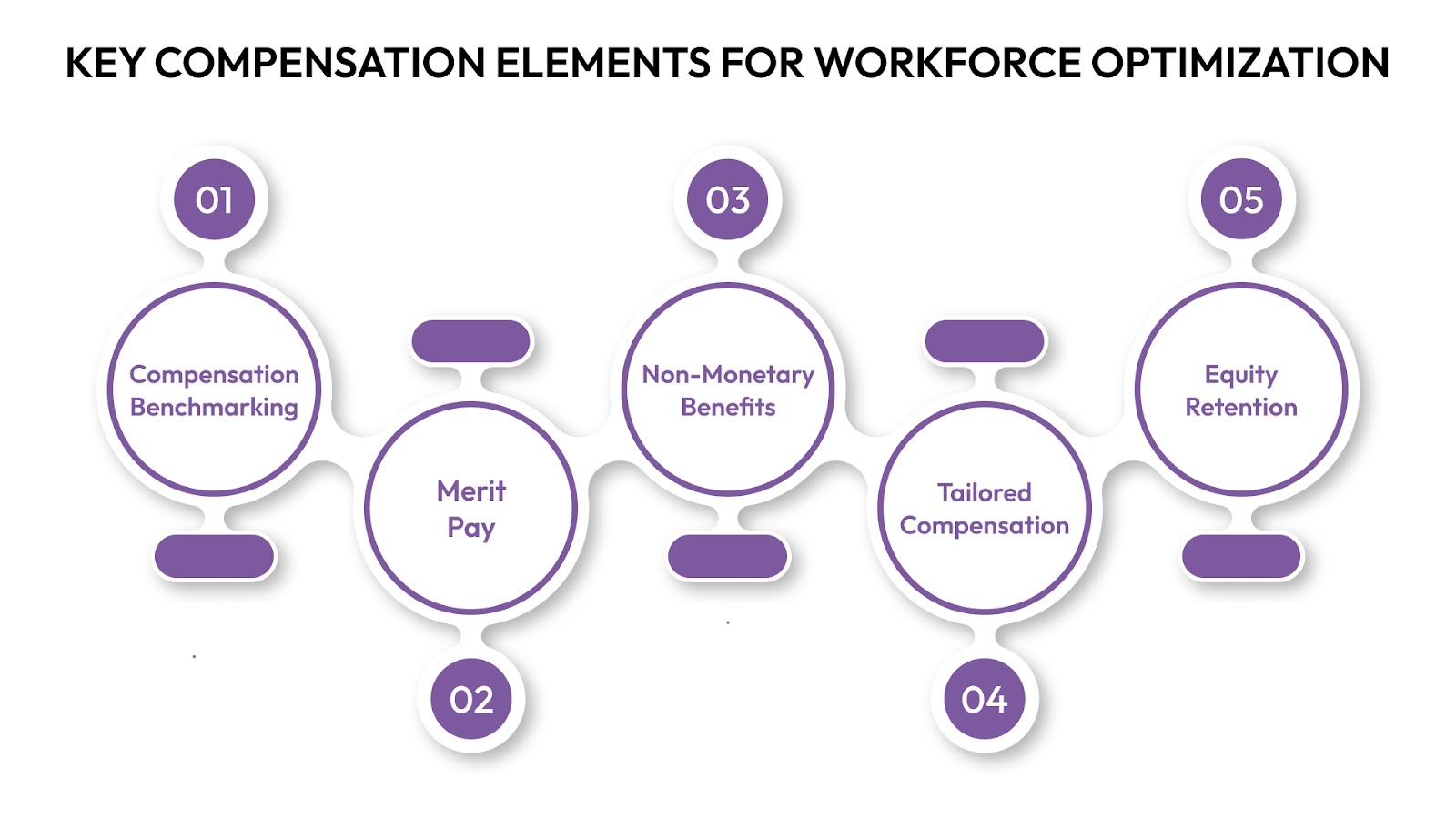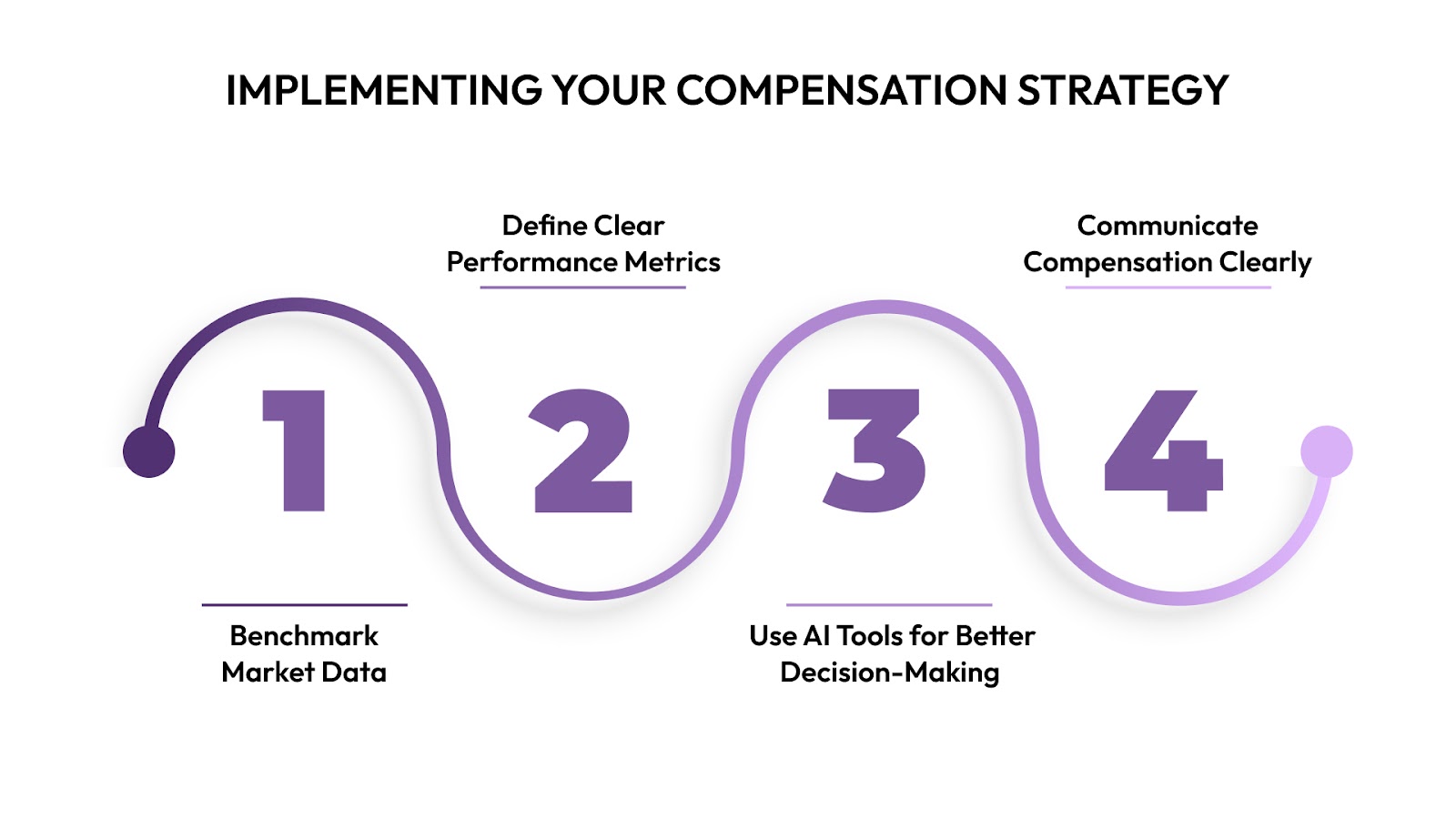Effective Compensation Strategies for Workforce Optimization
Explore effective employee compensation strategies to optimize workforce performance, enhance employee satisfaction, and align compensation with business goals.

Let’s be honest: If your compensation strategy still relies on outdated pay scales and generic benefits, you’re probably losing top talent. Employee compensation strategies today go far beyond just a paycheck. They drive performance, keep employees motivated, and align directly with your business goals.
The modern workforce is looking for more than just a salary. They want flexibility, recognition, and compensation that reflects their value. So, how can your company build a workforce that’s truly optimized? It starts with rethinking your compensation approach.
Let’s understand the employee compensation strategies that attract top talent and keep them engaged and performing at their best.
TL;DR
- Employee compensation strategies drive employee engagement and align performance with organizational goals.
- Key compensation elements like salary, benefits, and performance incentives optimize workforce productivity and retention.
- Designing a compensation plan focused on workforce optimization enhances both employee performance and satisfaction.
- Challenges such as budget constraints and pay equity can be managed through strategic planning and regular audits.
- Regular compensation assessments and market benchmarking ensure your strategy stays competitive and aligned with industry standards.
What Are Employee Compensation Strategies?
Employee compensation strategies refer to the methods used to reward employees for their contributions. This includes base salary, bonuses, benefits, and long-term incentives like stock options or retirement plans.
A well-structured compensation strategy plays a critical role in shaping employee satisfaction, performance, and overall company success.
Why They Matter for Workforce Optimization

Understanding the importance of compensation strategies is essential for optimizing workforce performance and ensuring long-term success.
- Attraction and Retention: Competitive compensation helps attract top talent and reduces the risk of losing key employees to competitors.
- Motivation and Engagement: Tying compensation to individual or team goals boosts motivation and drives better performance across the organization.
- Alignment with Business Objectives: A clear strategy ensures that employees’ work supports the company’s goals, making the entire workforce more efficient and focused.
After understanding employee compensation strategies, the next step is to learn about the key elements that drive workforce optimization and performance.
Key Compensation Elements for Workforce Optimization

To optimize workforce performance and engagement, a compensation strategy should include a balance of salary, performance incentives, and benefits. These elements help ensure that employees are motivated, aligned with company goals, and remain committed to the organization.
1. Salary Benchmarking for Competitive Compensation
Regularly benchmarking your compensation against the market helps ensure your salaries are competitive and fair. It allows you to remain attractive to top talent while maintaining internal equity.
- Gather Market Data: Companies should regularly collect data from salary surveys, industry reports, and job boards to compare their compensation packages with those of their competitors.
- Set Pay Ranges: By establishing minimum and maximum salary bands for each role, companies ensure consistency and fairness. For example, a company might set a salary range for a project manager role between $70,000 and $90,000, adjusting based on experience and location.
- Maintain Transparency: Clearly communicating how salaries are determined and offering regular updates on market trends builds trust with employees. For example, a company might hold annual meetings to discuss salary benchmarking findings and how compensation decisions are made.
2. Performance-Based Compensation
When compensation is tied to performance, it motivates employees to focus on achieving measurable results. Linking pay to individual, team, or company performance aligns employee goals with business outcomes.
Example: A sales team at a software company receives a 10% bonus on top of their salary for meeting quarterly sales targets. This motivates the team to exceed their targets, driving business growth and personal earnings.
3. Non-Monetary Benefits
Non-monetary benefits are just as crucial for maintaining a motivated and loyal workforce. These benefits support employees' well-being and improve overall job satisfaction, often influencing retention more than salary alone.
Example: A company offers employees flexible working hours and access to a wellness program, including mental health support. Employees can adjust their schedules to fit family needs or personal well-being, leading to a more engaged and less stressed workforce.
4. Customizing Compensation Models for Your Workforce
Every organization’s workforce has unique needs. By adjusting compensation models to reflect the roles, regions, and business goals of employees, companies can maintain fairness while keeping compensation competitive.
- Location-Adjusted Pay: For companies with a global workforce, paying employees based on the cost of living in their area ensures fairness. For example, employees in high-cost regions, like San Francisco, may receive a higher salary than those in smaller cities to account for the higher cost of living.
- Performance-Linked Pay: For roles where success is directly tied to performance, such as sales, offering commission-based pay encourages employees to exceed expectations. A retail company, for instance, could offer sales staff a percentage of each sale, motivating them to perform at their best.
- Standard Salary Models: Some roles, like administrative support, may be better suited to a consistent salary model. For example, a marketing coordinator receives a fixed salary with set annual raises based on performance reviews, ensuring stability in compensation.
5. Equity Compensation for Long-Term Retention
Equity compensation, such as stock options or performance shares, provides employees with a stake in the company’s success. This encourages long-term commitment and aligns employees’ goals with the company’s growth.
Example: A startup offers key employees stock options, allowing them to purchase shares at a set price. This motivates employees to work towards the company’s success, as they will benefit financially if the company grows and the value of their shares increases over time.
Building on these key elements, let’s design a compensation plan that aligns with your company’s goals.
Designing Compensation Plans for Workforce Optimization
An effective compensation plan isn’t just about offering competitive pay. It’s about ensuring fairness, optimizing employee performance, and aligning compensation with business goals.
By leveraging tools that support geo-adjusted compensation, data-driven decision-making, and transparent communication, companies can build compensation plans that drive workforce optimization.
Geo-Adjusted Compensation
Adapting compensation to regional market conditions ensures fairness and competitiveness, especially in a global workforce. Companies in the SaaS, fintech, e-commerce, and professional services industry with a diverse geographic footprint must adjust pay to reflect the local cost of living. This helps attract and retain top talent.
CandorIQ’s Payband Builder allows organizations to create geo-adjusted pay ranges by level, location, and department. This tool ensures pay equity across regions and departments while simplifying the management of pay bands.
See how CandorIQ’s Payband Builder optimizes geo-adjusted compensation.
AI-Powered Decision Making
AI tools help HRBPs automate compensation decisions, providing insights based on historical data and workforce trends. Using AI in compensation management allows organizations to make more informed and precise decisions that align with both market standards and internal goals.
CandorIQ’s AI Agent provides data-driven insights, recommending optimal pay ranges and identifying potential gaps in compensation structures. This AI-powered tool streamlines compensation management by helping HR teams analyze data and forecast future needs with precision.
Learn how CandorIQ’s AI Agent optimizes compensation decisions.
Pay Transparency
Clear communication about pay structures builds trust and fosters a more satisfied, engaged workforce. When employees understand how their compensation is determined, it not only improves morale but also reduces turnover and misalignment.
CandorIQ’s Candidate Offers tool promotes transparency by allowing employees to view the full details of their total compensation, including salary, equity, bonuses, and benefits. This transparency helps employees understand their full value and increases overall satisfaction.
Discover how CandorIQ’s Candidate Offers fosters transparency.
A well-crafted compensation plan sets the foundation, but addressing key challenges ensures it continues to drive workforce optimization.

Overcoming Compensation Strategy Challenges
Creating a strong compensation strategy is just the beginning. Overcoming common challenges like budget constraints, employee expectations, and pay equity ensures your plan remains effective and helps optimize your workforce.
Budget Constraints
Small businesses often have limited budgets for compensation, but can still offer competitive packages by focusing on performance-based pay and non-monetary benefits. These approaches allow companies to reward employees for their contributions without exceeding their financial limits.
To overcome this challenge, consider implementing variable pay structures, such as bonuses tied to individual or team performance. Non-monetary benefits like flexible work hours, professional development opportunities, and wellness programs can also enhance employee satisfaction without straining the budget.
Employee Expectations
Today’s employees expect more than just a salary. They seek remote work options, career development opportunities, and a better work-life balance. Aligning your compensation strategy with these expectations can improve employee satisfaction and reduce turnover.
Address this challenge by regularly reviewing your workforce's needs. Offer benefits such as remote work flexibility, training programs, and wellness support to ensure employees feel valued and stay engaged with the company. Aligning your employee compensation and benefits strategy with modern expectations can lead to better retention.
Ensuring Pay Equity
Ensuring pay equity is essential for a fair and motivated workforce. Regular pay equity audits help identify any pay gaps and ensure compensation is fair across the organization.
To overcome this challenge, implement a regular process for pay equity analysis and ensure that compensation is consistent across all departments and demographics. By making pay equity a priority, you help foster a culture of trust and fairness, which in turn improves retention and employee morale.
With these challenges addressed, it’s time to focus on the practical steps needed to put your employee compensation strategies into action.
Implementing Your Compensation Strategy

To ensure that your employee compensation strategies are effectively implemented, follow these key steps. These actions will help you optimize your workforce, drive productivity, and align compensation with your company’s goals.
1. Benchmark Market Data
To keep your compensation competitive, you must regularly gather salary data and compare your pay ranges against industry standards. This will help ensure that your compensation package remains attractive to top talent.
- Collect salary data from industry reports, salary surveys, and professional networks.
- Compare your workforce compensation strategies with similar companies in your industry to ensure competitiveness.
- Update pay ranges yearly, considering both market trends and internal feedback, to maintain fairness and alignment with industry standards.
2. Define Clear Performance Metrics
To motivate employees and align their performance with company goals, it’s essential to link pay increases and bonuses to clear, measurable performance metrics.
- Set specific, achievable goals for employees that directly tie into organizational objectives.
- Use performance reviews to evaluate how well employees meet goals, which will impact their pay increases or bonuses.
- Ensure that the metrics are transparent, fair, and communicated regularly to keep employees motivated.
3. Use AI Tools for Better Decision-Making
AI tools can provide valuable data insights, making compensation management more efficient and accurate. Using AI in your employee compensation and benefits strategy helps improve decision-making.
- Use AI tools to analyze salary trends, identify pay gaps, and make predictions for future compensation needs.
- Automate routine compensation tasks, such as merit increases or bonus calculations, to save time and improve accuracy.
- Rely on AI-driven forecasting to assess the impact of your compensation decisions on the company’s budget and performance.
4. Communicate Compensation Clearly
Effective communication about how compensation is structured can improve trust and help align employee performance with business goals. Transparency is key to reducing misunderstandings and dissatisfaction.
- Ensure employees clearly understand how their compensation is determined, including salary, bonuses, and benefits.
- Regularly share information on how performance affects pay, so employees know what to expect.
- Provide a transparent process for merit increases, bonuses, and promotions to help employees understand how their efforts contribute to compensation changes.
By executing these steps, you can build employee compensation strategies that drive both employee performance and long-term organizational success.

Develop an Effective Compensation Strategy with CandorIQ
Designing a compensation strategy that aligns with business goals and keeps employees engaged can be difficult. CandorIQ simplifies this process by consolidating multiple tools into a single, unified system for managing compensation and headcount planning.
This helps ensure fair pay, aligns workforce plans with budgets, and provides transparency to HR, Finance, and leadership.
With solutions like geo-adjusted compensation, payband management, and AI-powered recommendations, CandorIQ supports data-driven decision-making. It eliminates spreadsheets and disconnected processes, helping HR teams and CPOs become strategic partners.
Contact us to learn how CandorIQ can help optimize your compensation strategy.
FAQs
Q1. How do I determine the right salary range for different positions within my company?
A1. To determine salary ranges, use salary benchmarking tools to compare against industry standards. Ensure your workforce compensation strategies align with market trends and internal equity. Regular updates based on roles, experience, and company goals help maintain competitive and fair compensation.
Q2. How often should I update my employee compensation strategy to stay competitive?
A2. It’s important to review your employee compensation strategies at least annually or after significant market changes. Regular updates ensure your compensation plan stays competitive, attracting and retaining top talent while supporting workforce optimization and aligning with industry standards.
Q3. What factors should I consider when designing a compensation plan for a remote workforce?
A3. For remote workforces, consider geo-adjusted pay based on the cost of living in different regions. Additionally, offer flexible work hours, wellness programs, and career development opportunities as part of your workforce compensation strategy to enhance employee satisfaction and retention.
Q4. How can I align my compensation strategy with my company's growth goals?
A4. Align your employee compensation and benefits strategy with growth objectives by setting performance-based incentives. Tying pay increases to company milestones, such as revenue or team expansion, helps ensure your compensation plan supports both individual performance and broader organizational goals.
Q5. What is the best approach to compensate employees at different job levels within the company?
A5. Use pay bands to structure compensation according to job responsibilities, experience, and market value. Regularly review your workforce compensation strategies to ensure fairness and consistency across job levels, making adjustments based on industry standards and internal growth.


